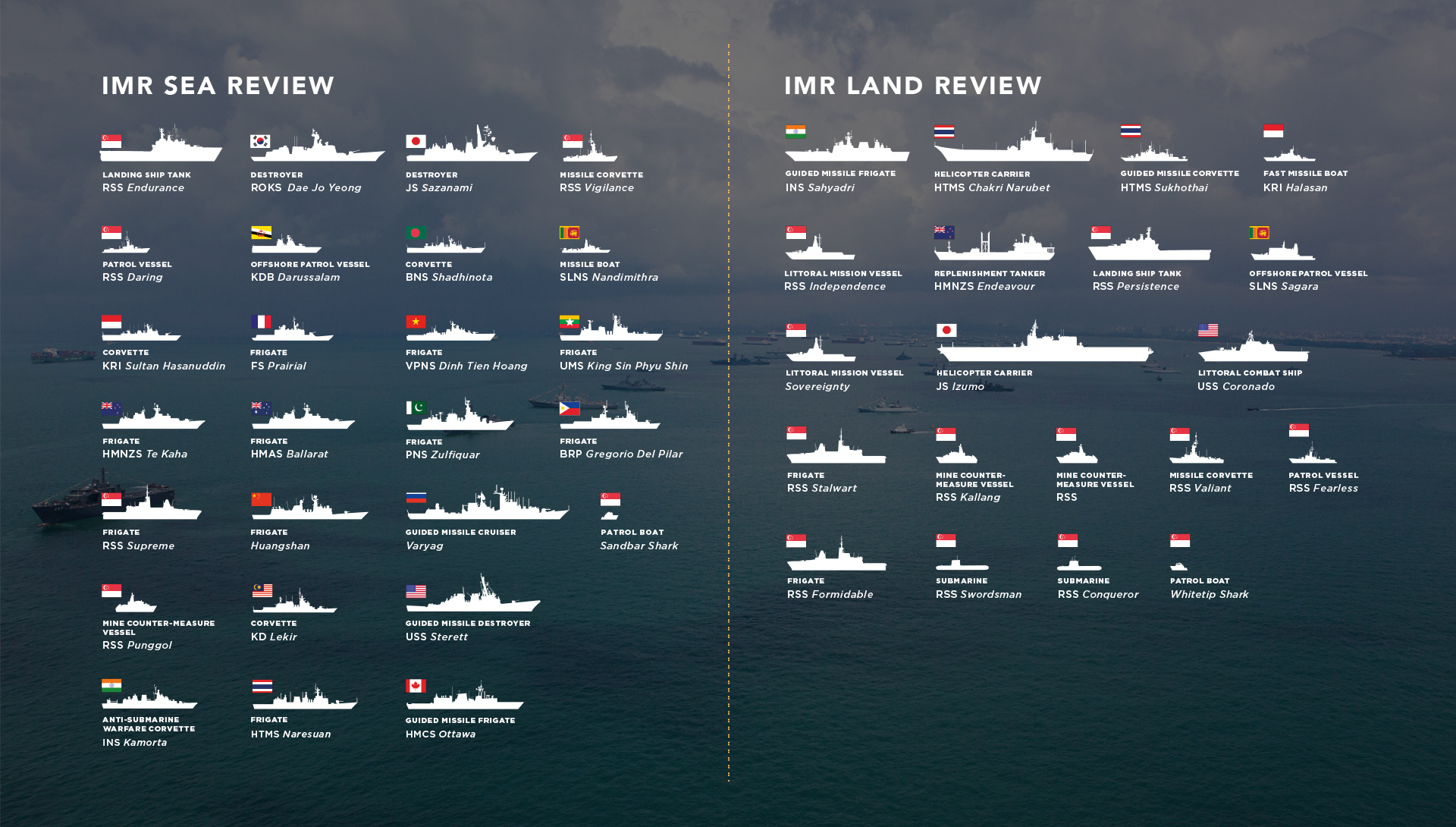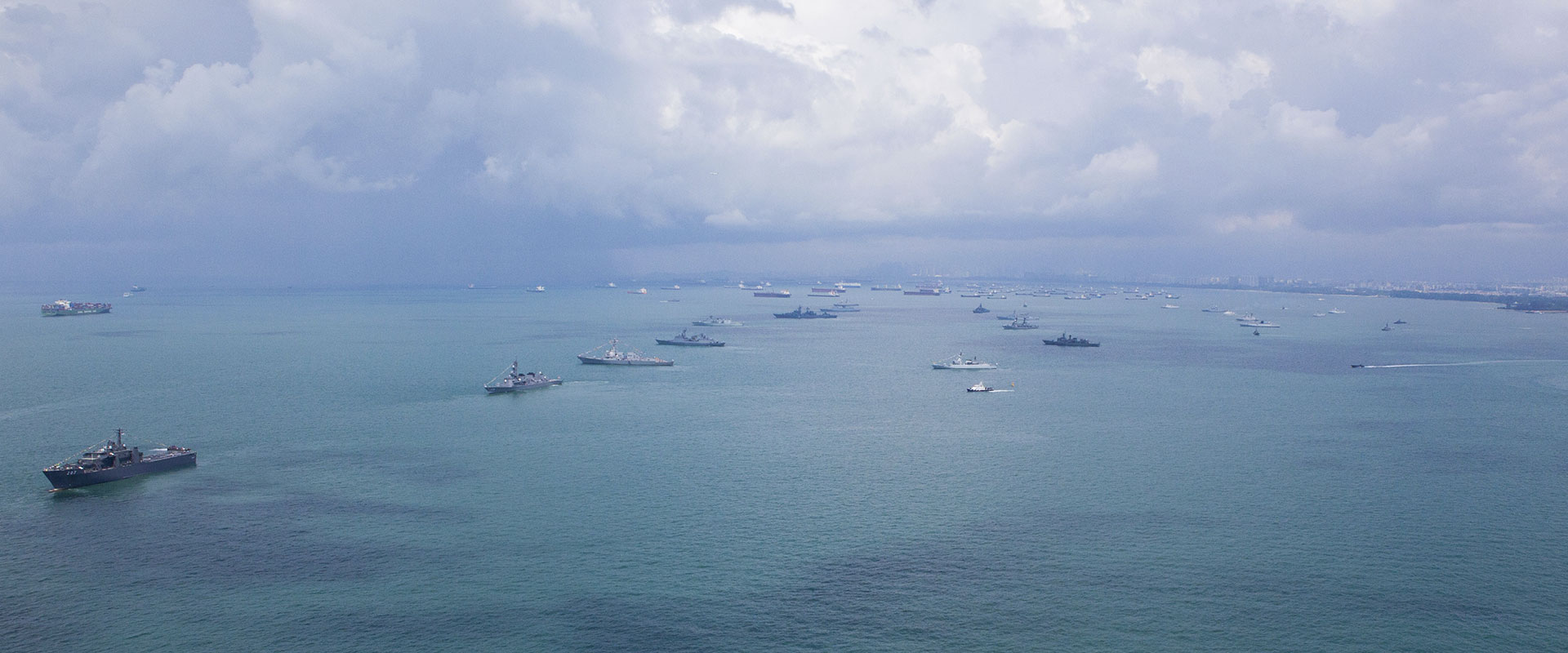With 21 navies from all across the world gathered at our doorstep, the first Singapore International Maritime Review was a celebration unlike any other.
The morning of 15 May 2017, 46 warships gathered around RSS Singapura – Changi Naval Base under a blazingly blue sky . In various shades of grey and green, they gleamed in the sunlight, with their brilliantly coloured flags streaming in the wind. The Singapore Strait had never looked this colourful.
The occasion? Singapore’s first International Maritime Review (IMR).
This was a gathering of navies unlike anything we had seen before. The Republic of Singapore Navy (RSN) was celebrating our 50th birthday, and we had invited the world to celebrate with us.
50 years
Maritime reviews are a long-standing custom practiced by navies worldwide. Traditionally a show of strength, today they unite navies for special occasions — in this case, the Republic of Singapore Navy’s 50th anniversary
Inspection
During a maritime review, ships are lined up in formation for ceremonial inspection. The ship is also “dressed” in signal flags, making for an eye-catching display
46
The Singapore International Maritime Review was made up of a Land Review, where the President reviewed 20 ships at harbour, and a Sea Review, where he reviewed 26 ships out at sea
Putting Together an International Parade
Starting three days before the IMR, guests from 44 countries streamed into Singapore. This included 28 warships from 20 foreign navies, more than 30 navy chiefs, vice navy chiefs and coast guard directors-general, and more than 40 flag officers.
When you throw a party on an international scale, planning and execution require a tremendous amount of detail. For a few, such details could only be settled on the big day itself.
This time crunch was particularly felt by 2WO Melvin Tan and his fellow parade trainers. The bulk of the parade participants – 300 of them! – only started to arrive in Singapore only three days earlier. They were representing the 21 other nations marching in the IMR parade. And it was the job of the trainers to get them parade-ready just a day before the IMR started.
“It was a challenge to get everyone who just recently met to march together cohesively, but as the saying goes, there’s a first time to everything – and I welcomed the challenge,” 2WO Tan said.
With at least 15 different languages spoken amongst the contingents, the trainers used “simple drills in simple English, with a [demonstration] video of specific drills used in the parade, such as at ease [and] at attention,” said trainer 2WO Steve Ng.
These tips and tricks definitely paid off during the parade; the foreign contingents stood at attention, perfectly in line with our Singapore contingent and the guard of honour from the Naval Diving Unit.
Anatomy of a Sea Review
As the IMR proceeded on land, a patrol vessel (PV) continued to watch over sea security in the waters off RSS Singapura – Changi Naval Base. With so many foreign warships in the Singapore Strait, the RSN had to see to the safety of not only the ships, but also the merchant vessels and passenger ferries that ply the waters. For the past three days, PVs had been conducting security sweeps and patrols in collaboration with the Police Coast Guard and the Maritime and Port Authority of Singapore.
“Our presence acted as a strong deterrent and prevented any unauthorised entries into the anchorage,” said MAJ Jonathan Liu, the commanding officer of PV RSS Daring. “The crew was involved in working out the security plans and contingencies prior to the big day, so that we are able to respond to any maritime security threats that may arise during the IMR.”
For RSS Daring, they pulled double-duty as the ship chosen to represent their squadron during the Sea Review, when the President sailed on littoral mission vessel RSS Independence to review the ships anchored out at sea.
“We were very excited … Preparations for the big day started months before … Maritime reviews are something that PVs hardly do,” explained MAJ Liu. “We also had to practise pointing ship , which means going against the tidal stream. My officers had to engage the engines to make the ship point in the desired direction when anchored, without dragging or damaging the anchor. It required precise skills and training, but we did it.”
During the Sea Review: RSS Daring pointed due east as planned, well aligned with the rest of the warships. The crew of RSS Daring lined the upper deck of the ship, standing proudly at attention in their pristine white. Their training had paid off.
Eyes in the Sky
At sea level, the view of the warships was marvelous. From the air? It was simply awe-inspiring.
The Sea Review concluded with a flypast comprising a Fokker-50 maritime patrol aircraft, a Sikorsky S-70B naval helicopter and two F-15SG fighter jets soaring above the warships. Seeing the nearly 50 warships arrayed in the sea below was a moment of great pride for ME3 Joseph Ng, a sensor supervisor on board the naval helicopter. “On our day-to-day flights, I see a few [foreign] warships transiting along Singapore Straits once in a while. This is my first time seeing warships from so many different countries gathered together in the Singapore Strait, all lining up in formation.
“I'm happy that I am one of the privileged few to be part of this milestone of the RSN,” he added. “It is like what our President said: [the IMR] is testament to the strong friendships and network Singapore has built across the world.”

HTMS Chakri Naruebet
Country: Thailand
Type: Helicopter Carrier
Commissioned: 1997
Distance from Thailand to Singapore: 1,635km

JS Izumo
Country: Japan
Type: Helicopter destroyer
Commissioned: 2015
Distance from Japan to Singapore: 5,241km
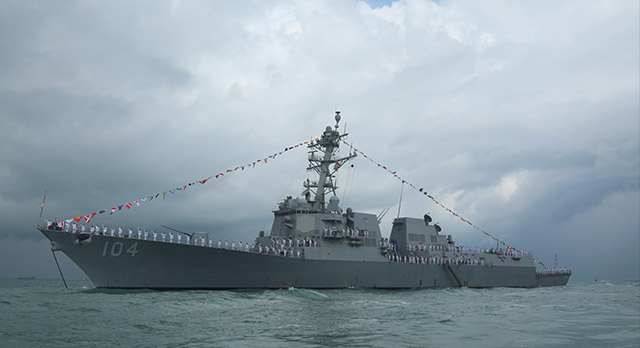
USS Sterett
Country: United States
Type: Guided-missile destroyer
Commissioned: 2008
Distance from USA to Singapore: 15,299km
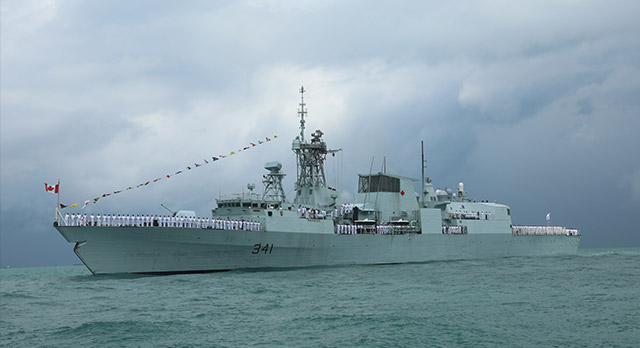
HMCS Ottawa
Country: Canada
Type: Frigate
Commissioned: 1996
Distance from Canada to Singapore: 13,076km
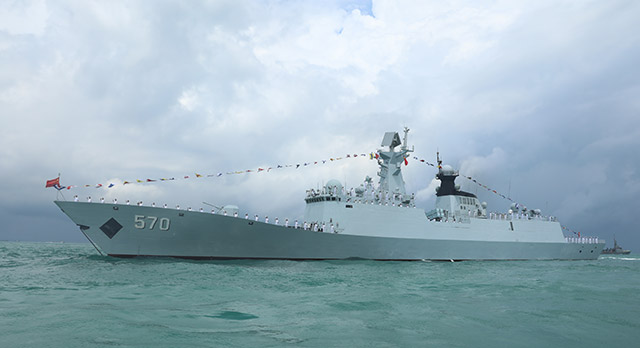
Huangshan
Country: China
Type: Frigate
Commissioned: 2008
Distance from China to Singapore: 3,835km
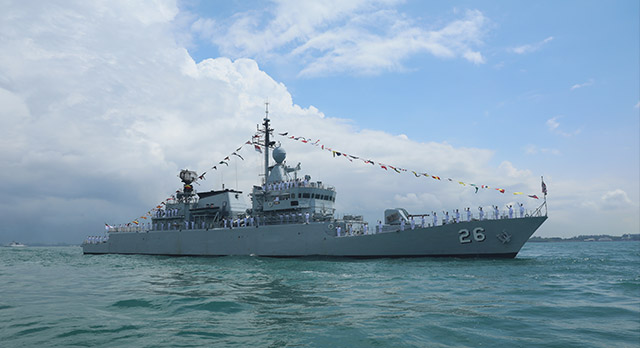
KD Lekir
Country: Malaysia
Type: Corvette
Commissioned: 1984
Distance from Malaysia to Singapore: 377km
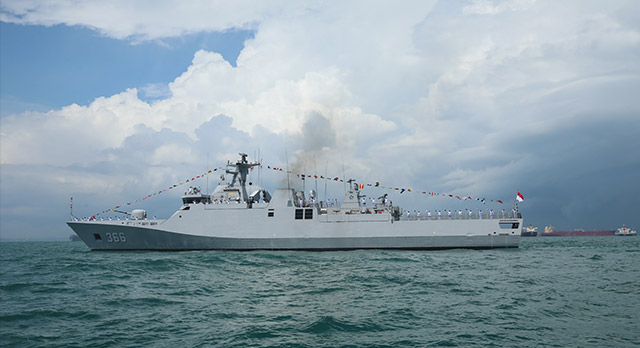
KRI Sultan Hasanuddin
Country: Indonesia
Type: Corvette
Commissioned: 2007
Distance from Indonesia to Singapore: 1,149km
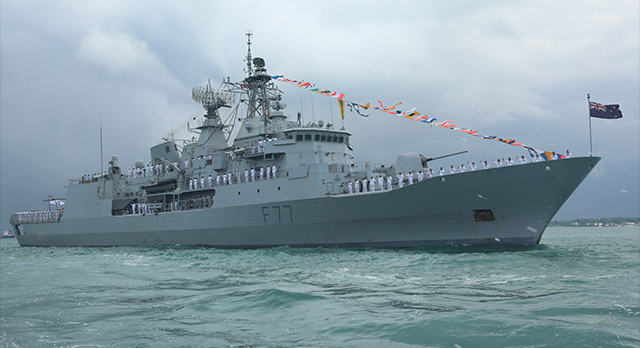
HMNZS Te Kaha
Country: New Zealand
Type: Frigate
Commissioned: 1997
Distance from New Zealand to Singapore: 8,529km

INS Kamorta
Country: India
Type: Corvette
Commissioned: 2014
Distance from India to Singapore: 3,440km
A Place Among Friends
In his opening address, President Tan reminded us: “Changi Naval Base is located along vital sea lanes connecting the Strait of Malacca and South China Sea, and plays a critical role in regional security.”
And building strong friendships across the world regionally and globally is one of the key methods the RSN employs to better protect our maritime nation. After all, sea trade is Singapore’s economic lifeline and what happens in waters halfway across the world will eventually affect us – even in waters as far flung as Canada.
“It’s awesome to come out here to see so many navies operating together,” said Lieutenant Bryan Peskett, operations officer on board Canada’s HMCS Ottawa. “And to see the ships in the anchorage with all their flags – lots of colour – and to do the review. It’s an honour to participate in the Golden Jubilee of the Singapore Navy.”
‘46 local and foreign warships’ is a mere statement on paper — until you see them proudly lined up together in our waters. The true scale of Singapore’s first IMR was thus revealed, with friends from all over the world gathered together for this special occasion. The review ship, RSS Independence, sailed by each ship in turn while foreign sailors lined the decks with friendly waves. While some stood firm and proud, like the sailors on board Russia’s guided missile cruiser Varyag, others, like those of Japan’s JS Sazanami, waved in choreographed unison. Myanmarese sailors on board Myanmar’s UMS King Sin Phyu Shin blared the ship’s horns and cheered.
As RSS Singapura — Changi Naval Base continues to host more than 100 foreign warships each year, deeper and more meaningful friendships will certainly be forged. Like any good party, participants end up leaving a new friend or two.
“[The IMR] is a big event,” said Captain M Rashed Sattar, commanding officer of BNS Shadhinota from the Bangladesh Navy. “As the commanding officer of this ship taking part, I am very proud [and] this ship and this ship’s crew are very, very happy to be part of the 50th anniversary of the Singapore Navy.”
Pointing ship is a particularly tricky manoeuvre. When ships are anchored, they are subjected to tidal stream, and will naturally point in the direction of the flow. To point the ship in a particular direction, which was required during the maritime review, the ship crew has to deliberately manoeuvre the ship against the powerful stream — and they have to do this without damaging the anchor
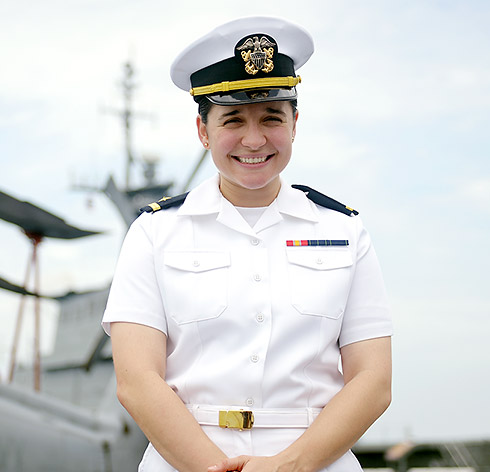
I think the best benefit [of IMR] is being able to interact with different countries. I met someone at the IMR, and her role was an Operational Specialist. She told me what she did and I interpreted it as similar to what I do, just under a different name. I have been deployed to Malaysia, Japan, Hong Kong and Indonesia and, as far as differences go… we’re really not very different.
Information Systems Technician First Class Christina Meno
Petty Officer, USS Coronado, United States
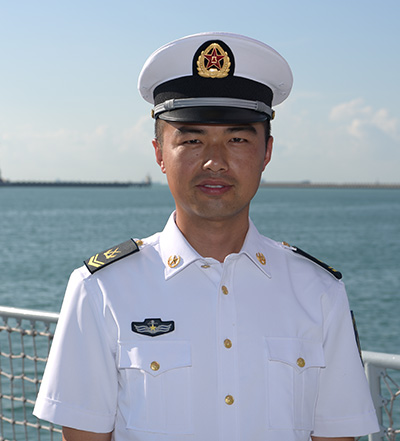
With 22 countries participating in the Review, it really shows the strength of each country’s good relationships with one another on the international stage … to have been able to bring people of such varied backgrounds, cultures, races, and languages together and ensuring such a smooth and successful event, is really a testament to the professionalism of everyone and the Singapore Navy, which is something that we can really learn from.
Petty Officer 1st Class Yu Chongyong
Avionic Mechanic, Huangshan, China

There is an impressive amount of organisation involved [in the IMR] and it’s great to be part of something big and historical. Not too often you get to see a review of this size.
Master Seaman Brian Bourassa
Sonar Operator, HMCS Ottawa, Canada

In a big picture, [the IMR] is a great avenue for navies to operate and address some of the petty conflicts from a national standpoint. This is an avenue for us to grow and cooperate with each other. Our navy is in a phase of developing its systems and capabilities and this is a good opportunity to have a better overview of what we can acquire in order to increase our navy’s strength and credibility.
Lieutenant Junior Grade Kim Talaban
Acting Operations Officer, BRP Gregorio del Pilar, Philippines
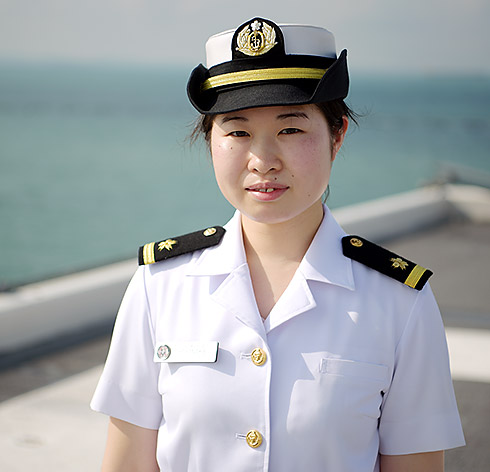
It’s my first time participating in such a large scale review, and I was very impressed by the sight of [so] many foreign vessels! Previously, I had only participated in exercises with the US Navy, and done sea rider exchanges with the French Navy. This review showed the friendship among all the different countries.
Ensign Hironaka
Navigation and Communication Officer, JS Izumo, Japan


